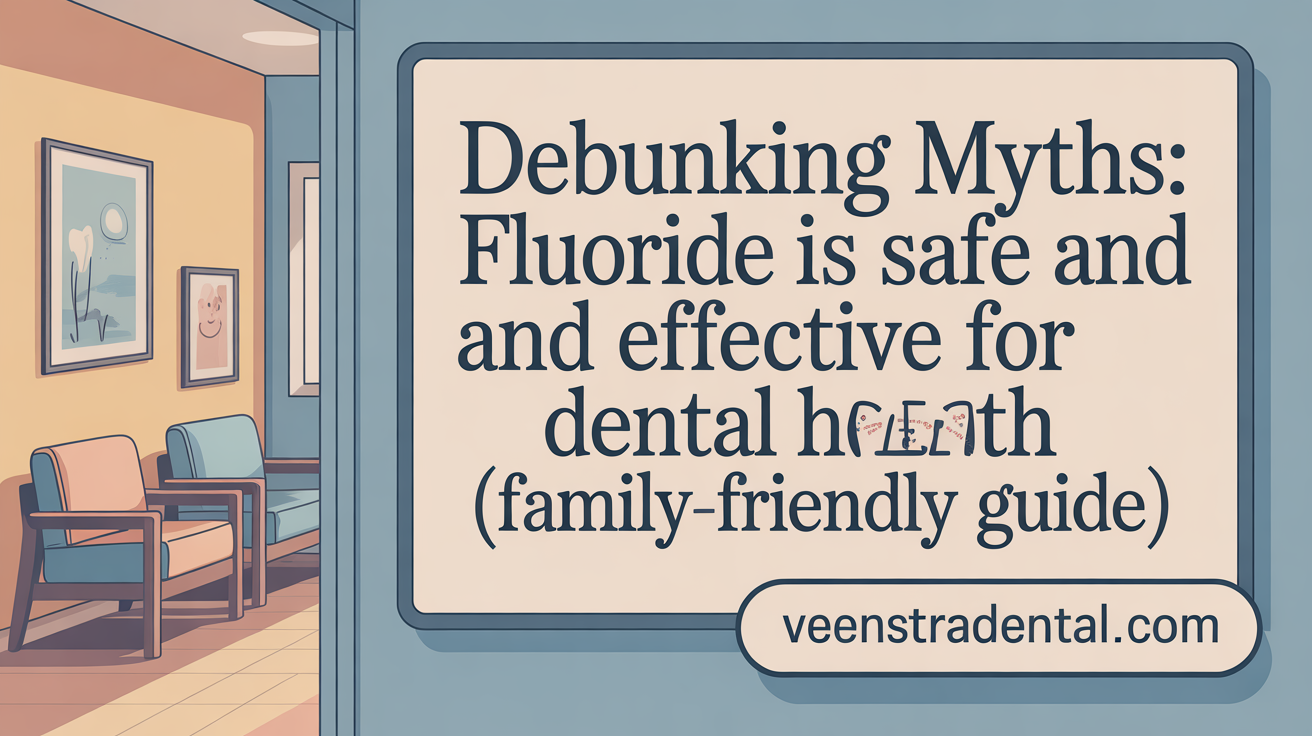Understanding Fluoride's Role in Dental Health and Public Safety
Fluoride has been a pivotal element in dental care and public health strategies for decades, yet it remains a subject of debate and misconception. This article delves into the scientific evidence supporting fluoride’s safety and benefits, debunks common myths, and explores the nuances of current research and public health policies. By examining credible studies and expert opinions, we aim to provide a clear perspective on fluoride’s role in preventing tooth decay and safeguarding community health.
The Scientific Consensus on Fluoride Safety and Benefits

What is the scientific consensus on the safety and benefits of fluoride in dental health?
The prevalent scientific viewpoint is that fluoride, when used at recommended levels, is both safe and highly effective in preventing dental cavities. Since the mid-20th century, extensive research and systematic reviews have consistently demonstrated the benefits of fluoride in maintaining oral health.
Major health organizations such as the Centers for Disease Control and Prevention (CDC), World Health Organization (WHO), American Dental Association (ADA), and other national health agencies agree that community water fluoridation significantly reduces tooth decay across all age groups.
Public health data shows that fluoridated water can lower the rate of untreated cavities by approximately 20% to 40%. The practice began in the U.S. in 1945 with Grand Rapids, Michigan, and has become a cornerstone of preventive dental care. This widespread adoption has contributed to a substantial decrease in dental problems, especially among children and underserved populations.
The main concern regarding fluoride side effects has been the occurrence of mild dental fluorosis, characterized by subtle white streaks or spots on teeth, which are mostly cosmetic and do not impair function.
Importantly, large-scale epidemiological and laboratory studies have found no credible evidence linking fluoride at standard community levels to cancer, developmental delays, or systemic health issues. Reviews conducted by several authoritative entities, including the National Toxicology Program and the National Research Council, support the safety profile of fluoridation.
In summary, scientific and medical research firmly establish fluoride as a beneficial, safe, and cost-effective tool for improving dental health, with a long history of positive public health outcomes worldwide.
Common Myths and Misconceptions About Fluoride

What are the common myths and misconceptions about fluoride use?
Many people hold misconceptions about fluoride, often fueled by misinformation and misunderstandings. A prevalent myth is that fluoride causes cancer or neurotoxicity at the levels used in community water fluoridation. However, comprehensive reviews by scientific authorities such as the CDC, EPA, and WHO have found no credible evidence linking fluoride at recommended levels to cancer or serious health problems.
Another misconception is that studies suggesting fluoride's harmful effects are directly applicable to public water fluoridation. Most research indicating potential risks involving IQ or neurodevelopment originate from regions with natural fluoride levels much higher than those used in community water systems. The fluoride added in U.S. water supplies is carefully regulated, typically at 0.7 ppm, well below harmful levels.
People also sometimes confuse naturally occurring fluoride with the fluoride added artificially. Natural fluoride in some areas can be at higher concentrations, which may cause dental fluorosis, but the controlled addition of fluoride is a safe public health measure, endorsed globally and by major health organizations.
Endorsements from reputable bodies like the American Dental Association, CDC, and World Health Organization support fluoride's safety and effectiveness in preventing tooth decay.
The spread of misinformation has contributed to skepticism about fluoride, with some claiming conspiracies involving government or industry. Well-conducted scientific studies, however, confirm that fluoridation reduces cavities and improves dental health at minimal risk.
In summary, most myths linking fluoride to serious health dangers are not supported by the extensive body of scientific research. When used at recommended levels, fluoride remains a safe, cost-effective, and essential tool in promoting oral health globally.
Fluoride and Neurological Health: Examining the Evidence
Recent research on fluoride and IQ
Emerging studies have explored the potential link between fluoride exposure and cognitive development in children. Some research, primarily from regions with high natural fluoride levels, suggests a possible association between elevated fluoride intake and reduced IQ scores. These studies generally report that children exposed to fluoride levels exceeding 1.5 mg/L may experience small decreases in IQ points. Most of these investigations observe a dose-response pattern, where higher fluoride concentrations correlate with greater IQ reduction.
Fluoride exposure levels in studies
The majority of experimental and epidemiological studies indicating potential neurological effects involve fluoride concentrations significantly higher than those used in community water fluoridation. For instance, levels of 4 mg/L or more, common in some natural fluoride-rich areas, have been associated with cognitive deficits. In contrast, the fluoride level recommended for community water fluoridation—about 0.7 mg/L—is well below these thresholds, and current evidence at this optimal dosing is inconclusive.
Differences between natural high fluoride areas and community fluoridation
Regions with naturally high fluoride levels often report adverse health effects, but these are from naturally occurring fluoride sources that significantly surpass optimal added fluoride levels. Natural fluoride concentrations can reach 4 mg/L or higher, which is associated with both dental fluorosis and potential neurotoxicity. In the United States and many other countries, controlled water fluoridation maintains fluoride levels around 0.7 mg/L, a practice supported by extensive safety reviews and aimed at reducing dental decay without risking systemic toxicity.
Limitations of current data on cognitive effects
Many studies suggesting neurotoxicity are conducted in areas with high natural fluoride levels or involve exposure to fluoride well above regulated standards. These findings may not accurately reflect the effects of fluoride at the levels used in water fluoridation. Furthermore, research often faces limitations such as small sample sizes, confounding factors like socioeconomic status, and environmental variables. Consequently, global health organizations highlight the need for more rigorous, controlled studies to determine any causal relationship at typical exposure levels.
Recommendations for monitoring fluoride levels
Given the current evidence, health authorities recommend regular monitoring of fluoride levels in public water supplies to ensure they remain within safe and effective ranges. The U.S. CDC recommends 0.7 mg/L, a level supported by decades of research showing optimal balance between dental benefits and minimal risk of fluorosis or other adverse effects. Continued surveillance is essential, especially for vulnerable groups such as infants and pregnant women, to prevent excessive fluoride exposure while maintaining dental health benefits.
In summary, while some research hints at possible neurological effects at high fluoride levels, evidence at the community fluoride levels of 0.7 mg/L remains limited and inconclusive. Ongoing monitoring and research are necessary to confirm the safety of fluoride as a public health measure, especially for early childhood development.
Fluoride’s Role in Public Health Policy and Water Fluoridation

What is the role of fluoride in public health policies like water fluoridation?
Fluoride is a vital component of oral health strategies, particularly in public health policy through water fluoridation programs. Its primary function is to prevent dental cavities by strengthening tooth enamel and helping to reverse early decay. The optimal fluoride level in community water, set at 0.7 milligrams per liter by health authorities, aims to maximize dental benefits while minimizing risks like fluorosis.
Implementing water fluoridation across communities significantly reduces the prevalence of cavities, with studies indicating decreases of about 25% in dental decay. This community-wide approach ensures equitable access to dental health benefits, regardless of individual income or access to dental care.
Major health organizations, including the CDC, American Dental Association, and WHO, endorse water fluoridation as a safe, effective, and cost-efficient public health intervention. It not only improves oral health outcomes but also reduces the economic burden associated with dental treatments, saving communities billions annually.
By adjusting fluoride levels in public water supplies to the recommended 0.7 mg/L, public health policies aim to promote healthier teeth for the entire population, especially benefiting underserved and vulnerable groups. Extensive research supports the safety and effectiveness of this practice, confirming its role as a cornerstone of preventive dentistry and community health.
Addressing the Reasons Some Stop Using Fluoride Toothpaste
 Many individuals choose to avoid fluoride toothpaste due to concerns about potential health risks, such as toxicity, dental fluorosis, or environmental effects. Misinformation or misunderstandings about fluoride safety often play a significant role. Despite extensive scientific research confirming that fluoride at recommended levels is safe and effective in preventing cavities, some people remain wary.
Many individuals choose to avoid fluoride toothpaste due to concerns about potential health risks, such as toxicity, dental fluorosis, or environmental effects. Misinformation or misunderstandings about fluoride safety often play a significant role. Despite extensive scientific research confirming that fluoride at recommended levels is safe and effective in preventing cavities, some people remain wary.
A common reason for avoiding fluoride toothpaste is fear of overexposure, especially among parents who worry about fluoride ingestion by children. While fluoride helps strengthen enamel and reduce cavity risk, concerns about excessive intake leading to fluorosis—a cosmetic condition characterized by white stains on teeth—can influence parental choices.
Alternatives to fluoride toothpaste exist, including products containing baking soda, herbal extracts, or other natural ingredients. However, these alternatives generally offer less proven protection against cavities compared to fluoride-containing toothpastes.
For children, parents often prefer to limit fluoride exposure unless it is supervised by dental professionals. Some believe that natural or herbal toothpastes are safer, even though they may not provide the same level of cavity prevention.
From a scientific perspective, fluoride toothpaste is considered very safe when used as directed. Studies and health organizations like the CDC and ADA endorse its use, emphasizing that the amount of fluoride in toothpaste is designed to optimize cavity prevention while minimizing risks of fluorosis.
In summary, while some individuals stop using fluoride toothpaste due to health concerns, evidence indicates that it plays a crucial role in maintaining dental health. Consistent use of fluoride toothpaste significantly reduces cavities, safeguarding oral health throughout life.
Historical and Industrial Origins of Fluoride Use
What was fluoride originally used for before its role in dental health?
Fluoride's history predates its reputation as a dental health agent and is rooted in various industrial applications. Originally, fluoride was employed in manufacturing processes such as in the production of aluminum. It also found uses in the creation of refrigerants and as a component in the synthesis of different chemicals.
The connection between fluoride and teeth health emerged from observing natural water sources. Researchers in the early 1900s discovered that regions with high natural fluoride levels in water suffered from dental fluorosis, which manifests as white stains on the teeth. Interestingly, these high levels also correlated with stronger enamel and fewer cavities.
This observation led scientists to realize that fluoride could provide protective benefits for teeth. The shift from industrial use to public health application began in the mid-20th century when community water fluoridation initiatives were introduced.
Today, fluoride used in water treatment is derived from chemicals like sodium fluoride, hydrofluorosilicic acid, and sodium silicofluoride, which are added at controlled levels to prevent tooth decay. Despite its industrial origins, fluoride’s role in dentistry has become a cornerstone of oral health efforts worldwide.
Fluoride Chemistry and Its Mechanism in Preventing Tooth Decay

How fluoride binds to and strengthens enamel
Fluoride chemically interacts with tooth enamel, forming a compound called fluoroapatite. This process makes the enamel more resistant to acids produced by bacteria, which are responsible for tooth decay. When fluoride is present in the mouth, it helps to repair early stages of tooth demineralization, making the surface stronger and more resistant to cavities.
Topical vs systemic effects of fluoride
Fluoride works primarily in a topical manner after teeth have erupted, strengthening enamel directly through contact. It also has systemic effects, as fluoride incorporated into unerupted teeth during development provides internal protection. Most cavity prevention benefits stem from topical fluoride, used through toothpaste, gels, or mouth rinses, although drinking fluoridated water also contributes to systemic exposure.
Role in remineralization and decay prevention
Fluoride enhances the natural remineralization process by helping to rebuild damaged enamel. It aids in replacing mineral loss caused by acids, reversing early decay signs. Fluoride forms a more acid-resistant form of mineral on the teeth, reducing the likelihood of cavities forming over time.
Fluoride compounds used in water treatment
In water fluoridation, common compounds include sodium fluoride, hydrofluorosilicic acid, and sodium silicofluoride. These compounds dissociate in water to release fluoride ions, which then bond with tooth enamel. The chosen compounds are considered safe and effective, and their use is carefully regulated to stay within optimal levels.
Relation to dental health improvements
Decades of research show that fluoride in community water reduces tooth decay by approximately 20% to 40%. This long-lasting benefit helps maintain healthy teeth into adulthood. Additionally, fluoridation is cost-effective, saving communities significant dental treatment costs annually. Major health organizations endorse fluoride's role in improving public dental health, emphasizing its safety and effectiveness when used at recommended levels.
Fluoride: A Scientifically Supported Ally in Oral Health
Amidst a landscape of misinformation and debate, the scientific evidence firmly supports fluoride’s role as a safe and effective agent in promoting dental health and preventing cavities. Extensive research, expert consensus, and decades of public health implementation demonstrate that water fluoridation and fluoride dental products have brought measurable benefits in reducing tooth decay, especially for vulnerable populations. While ongoing research continues to monitor potential health impacts, current data at recommended fluoridation levels do not indicate significant risks. Dispelling myths and emphasizing evidence-based information is essential in fostering informed decisions and maintaining the oral health gains fluoride has afforded communities worldwide.
References
- Weighing Facts Against Myths in the Fluoride Debate
- [PDF] MYTHS & FACTS - DPBH (nv.gov)
- The truth behind that viral study on fluoride and IQ - STAT News
- Water Fluoridation and Cancer Risk | American Cancer Society
- The Fluoride Controversy | Office for Science and Society
- Common Fluoridation Myths Answered
- Fluoride Myths Debunked - Dentist in Greenville, TX - Wesley Dental
